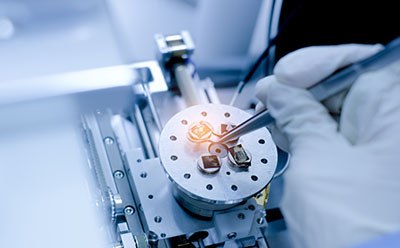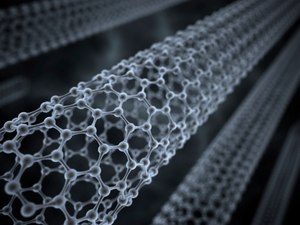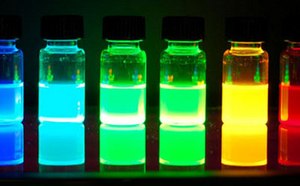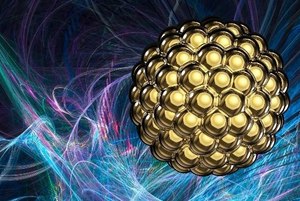Electron Microscopy

Electron microscopy is a technique used to obtain ultrahigh resolution images of individual atoms of materials and internal structures of cells. The resulting atomic-level or micro- and meso-structure images can be used to investigate the sample properties and behavior. It is used in materials science, biomedical research, quality control, and failure analysis. The use of electrons as the imaging radiation source allows for greater spatial resolution (on the tens of picometers scale) as compared to the resolution achieved using photons in optical microscopy (~200 nanometers). In addition to surface topography, information about crystalline structure, chemical composition, and electrical properties are obtainable through electron microscopy. Electron microscopy can be divided into two main categories: scanning electron microscopy (SEM) and transmission electron microscopy (TEM).
Featured Categories
Battery materials ensure reproducible data, supporting research needs from bench-scale to manufacturing for reliable performance.
Discover diverse carbon nanomaterials: fullerene, nanotubes, graphene, quantum dots, nanodiamonds. Fuel energy, electronics, therapeutics research.
Light up your research with our comprehensive portfolio of core-type, core-shell, and alloyed quantum dots in various compositions, sizes, functionalizations, and kits.
We offer a comprehensive portfolio of inorganic and metallic nanomaterials, functionalized nanoparticles, and nanomaterial kits for your research needs.
Scanning electron microscopy (SEM) uses a relatively low-power electron beam for imaging and interaction with the sample. Electron detectors identify secondary electrons at the surface and backscattered electrons in deeper regions. Secondary electrons are generated from inelastic interactions between the electron beam and the atoms of the sample. Backscattered electrons are generated after elastic interaction between the electron beam and the sample. SEM requires little to no sample preparation and is much faster and less restrictive than other types of electron microscopy. Large (~200 millimeter) samples can be directly imaged after mounting to a holder or stub. SEM commonly uses energy-dispersive X-ray spectroscopy (EDS or EDX) to map the distribution of elements within a sample. Electron beam-induced current (EBIC) and cathodoluminescence (CL) are other methods to analyze the high-quality images and optoelectronic properties of samples.
Transmission electron microscopy (TEM) uses a high-energy beam of electrons to transmit electrons through a sample to create a 2D image at the highest possible resolution. Nanomaterials can be analyzed through TEM to reveal their structure and composition information at the atomic level. Selecting the right sample holder (TEM grid) for different types of nanomaterials is vital to obtain the most detailed information. When samples are too thick, they must first be made thin enough for electrons to travel through them, ideally 100 nanometers or less. These TEM samples are then mounted onto a TEM grid and studied under ultrahigh vacuum conditions with a focused, intense electron beam. TEM utilizes the selected area diffraction (SAD) of electrons passing through the sample to provide crystallographic information about the sample material. Electron energy loss spectroscopy (EELS) and energy-dispersive X-ray spectroscopy (EDX) are methods of analysis to measure the atomic composition, chemical bonding, electronic properties, and local material thickness.
Scanning transmission electron microscopy (STEM) scans a focused electron beam (with typical spot size of 0.05-0.2 nm) over the sample to complete imaging and spectroscopic mapping simultaneously, allowing direct correlation of spatial information and spectroscopic data.
Visit our document search for data sheets, certificates and technical documentation.
Related Articles
- Nanomaterials are considered a route to the innovations required for large-scale implementation of renewable energy technologies in society to make our life sustainable.
- Nanomaterials for Energy Storage in Lithium-ion Battery Applications
- Researchers urged to develop renewable energy sources like wind and solar to mitigate fossil fuel's environmental impact.
- The critical technical challenges associated with the commercialization of electric vehicle batteries include cost, performance, abuse tolerance, and lifespan.
- Fluorescent Nanodiamond Particles (FNDs)- Find properties and applications of nanodiamond particles.
- See All (32)
Related Protocols
- Surfactant-assisted dispersion of single-walled carbon nanotubes for debundling or exfoliation in dispersion procedures.
- See All (1)
Find More Articles and Protocols
How Can We Help
In case of any questions, please submit a customer support request
or talk to our customer service team:
Email custserv@sial.com
or call +1 (800) 244-1173
Additional Support
- Chromatogram Search
Use the Chromatogram Search to identify unknown compounds in your sample.
- Calculators & Apps
Web Toolbox - science research tools and resources for analytical chemistry, life science, chemical synthesis and materials science.
- Customer Support Request
Customer support including help with orders, products, accounts, and website technical issues.
- FAQ
Explore our Frequently Asked Questions for answers to commonly asked questions about our products and services.
To continue reading please sign in or create an account.
Don't Have An Account?



